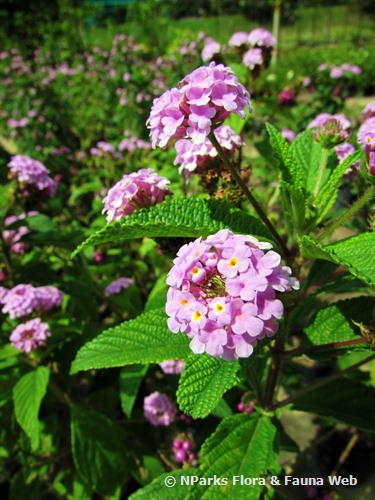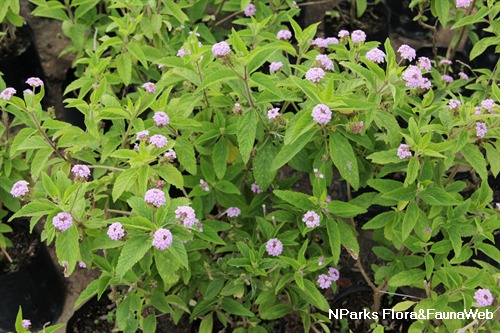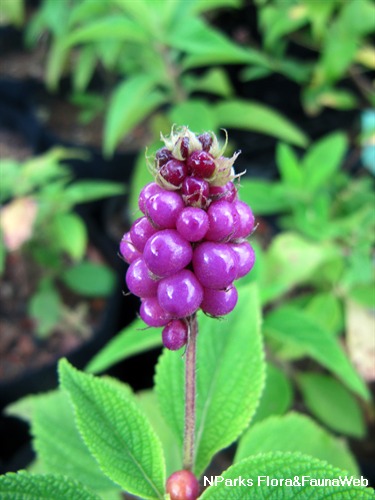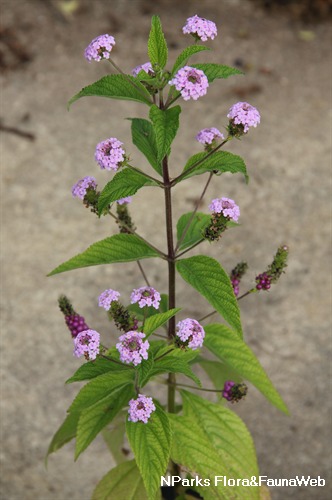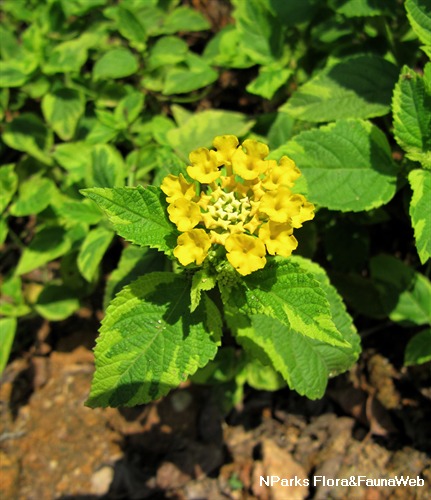
Back
Lantana trifolia L.
| Family Name: | Verbenaceae |
| Common Name: | Shrub Verbena, Three-leaved Lantana, Popcorn Lavender |
Name
Classifications and Characteristics
| Plant Division | Angiosperms (Flowering Seed Plants) (Dicotyledon) |
|---|---|
| Plant Growth Form | Shrub |
| Lifespan (in Singapore) | Perennial |
| Mode of Nutrition | Autotrophic |
| Plant Shape | Shrubby |
Biogeography
| Native Distribution | Central and South America, West Indies, Mexico |
|---|---|
| Native Habitat | Terrestrial |
| Preferred Climate Zone | Tropical |
| Local Conservation Status | Non-native |
Description and Ethnobotany
| Growth Form | Herbaceous shrub with an upright growth form, able to grow up to about 0.6 - 1 m tall and with a spread of about 0.3 - 0.6 m wide. It is commonly called as Three-leaved Lantana because the leaves usually appear in whorls of three. |
|---|---|
| Foliage | Simple leaves are arranged in whorls of three along the stem, measuring about 8 - 10 cm long; oblong to lanceolate shape with a serrated margin; leaf petiole is covered with hairs and the leaf surface is rough to the touch. |
| Flowers | Small lavender-coloured 5-lobed flowers borne in a cluster. |
| Fruit | Dark purple fruits in a cluster. These fruits appear popcorn-like that sometimes plants are also given common name as Lavender Popcorn. |
| Habitat | Usually found in damp thickets, abandoned cultivation, disturbed forests and roadsides. |
| Taxonomy | Genus name Lantana is the modern Latin name of the genus name Viburnum. |
| Etymology | The genus Lantana is and old Latin name for Viburnum. The specific epithet trifolia means trifoliate, which means having three leaflets. |
| Ethnobotanical Uses | Medicinal: The crushed leaves are mixed in hot water and drunk to treat rheumatism and indigestion. It was also said that the leaves are used to treat colds and ringworms. |
Landscaping Features
| Landscaping | Plants can be grown as rounded shrubs or trained. Once the flowers fade, the flowering spikes elongates to form popcorn-like spikes of purple, which makes the plant excellent as ornamental attraction for both its flowers and fruits. |
|---|---|
| Desirable Plant Features | Ornamental Flowers |
| Landscape Uses | Parks & Gardens, Small Gardens, Flowerbed / Border, Container Planting |
Fauna, Pollination and Dispersal
| Fauna Pollination Dispersal Associated Fauna | Butterfly-Attracting (Flower Nectar) |
|---|---|
| Pollination Method(s) | Biotic (Fauna) |
Plant Care and Propagation
| Light Preference | Full Sun |
|---|---|
| Water Preference | Moderate Water |
| Plant Growth Rate | Fast |
| Rootzone Tolerance | Drought Tolerant, Moist Soils, Well-Drained Soils, Poor Infertile Soils |
| Potential Problems | No serious insect or disease problems. However, watch for whiteflies and spider mites. |
| Pest(s) | Sucking Insects |
| Propagation Method | Seed, Stem Cutting |
Foliar
| Foliage Retention | Evergreen |
|---|---|
| Mature Foliage Colour(s) | Green |
| Mature Foliage Texture(s) | Rough |
| Prominent Young Flush Colour(s) | Green |
| Young Flush Texture(s) | Rough |
| Foliar Type | Simple / Unifoliate |
| Foliar Arrangement Along Stem | Whorled |
| Foliar Attachment to Stem | Petiolate |
| Foliar Shape(s) | Non-Palm Foliage (Lanceolate, Oblong) |
| Foliar Venation | Pinnate / Net |
| Foliar Margin | Serrate / Toothed |
| Foliar Apex - Tip | Acute |
| Foliar Base | Acute |
Floral (Angiosperm)
| Flower & Plant Sexuality | Bisexual Flowers |
| Flower Colour(s) | Pink, Purple |
|---|---|
| Flower Texture(s) | Smooth |
| Flower Grouping | Cluster / Inflorescence |
| Flower Location | Axillary |
| Flower Symmetry | Bilateral |
| Individual Flower Shape | Tubular |
| Inflorescence Type | Spike |
| Flowering Period | Free-Flowering |
| Flower Lifespan on Plant | Several Days |
Fruit, Seed and Spore
| Mature Fruit Colour(s) | Purple |
|---|---|
| Mature Fruit Texture(s) | Glossy / Shiny |
| Fruit Classification | Simple Fruit |
| Fruit Type | |
| Seed Quantity Per Fruit | Few (1-5) |
Image Repository
Others
| Master ID | 31451 |
|---|---|
| Species ID | 5848 |
| Flora Disclaimer | The information in this website has been compiled from reliable sources, such as reference works on medicinal plants. It is not a substitute for medical advice or treatment and NParks does not purport to provide any medical advice. Readers should always consult his/her physician before using or consuming a plant for medicinal purposes. |

